- 오늘 월소득 한 달분 vs 1년 후 두 달분 수령, 당신의 선택은? - Gallup International 다국가 조사 #75주년 #현재편향
- 조사일 : 2022/10/31
- [GallupReport(20230420)_ExtraPayment_GIA75.pdf] 다운로드
● 2023년 4월 20일(목) 공개 | 문의: 02-3702-2571/2621/2622
오늘 월소득 한 달분 vs 1년 후 두 달분 수령, 당신의 선택은?
Gallup International 75주년 다국가 조사
→ 한국+세계 조사 결과 파일 다운로드(PDF)
/ 세계 조사 개요
- 2022년 8~10월 56개국 성인 총 53,321명 전화/온라인/면접조사(주제별 참여국 상이)
/ 한국 조사 개요
- 조사기간: 2022년 8월 23~31일
- 표본추출: 사회연구패널★에서 성·연령·지역별 층화 추출
(한국갤럽이 무선전화 RDD 방식으로 구축·운영하는 확률 기반 조사패널)
- 응답방식: 모바일조사(조사대상자에게 문자메시지 발송, 자기기입식 웹조사)
- 조사대상: 전국 만 19~79세 1,035명
- 표본오차: ±3.0%포인트(95% 신뢰수준)
- 문자 발송 대비 응답 완료율: 46%(총 2,263명 중 1,035명)
- 의뢰처: 한국갤럽-Gallup International 자체 조사
조사 결과
2022년 8~10월 56개국 시민의 추가 소득 수령에 관한 생각 양분:
'오늘 당장 월소득 한 달분' 46%, '1년 후 월소득 두 달분' 42%
- 저소득 국가 현재 지향성 강한 편, 재정상 절박함·미래 불확실성 연관
갤럽 인터내셔널이 2022년 8~10월 56개국 시민 53,321명에게 소득 관련 두 가지 조건-오늘 당장 월평균 소득만큼의 추가적인 돈을 받는 것과 1년 후 월평균 소득 두 배만큼의 돈을 받는 것-이 제시된다면 어느 쪽을 선택할 것인지 물었다. 이는 심리학·행동경제학에서의 '현재 편향(present bias)', 미래의 더 큰 보상보다 작지만 즉각적인 보상 선호 경향을 엿볼 수 있는 질문이다. 조사 참여자들의 생각은 양분됐다. 46%가 '오늘 당장 월소득 한 달분 수령', 42%는 '1년 후 두 달분 수령'을 선택했고 12%는 의견을 유보했다.
◎ '오늘 당장 월소득 한 달분 수령' 의향자가 많은, 즉 재정상 현재 지향성이 강한 나라는 나이지리아(76%), 이라크(74%), 파키스탄·리비아(69%), 세네갈·아르헨티나(61%), 타이·케냐·시리아(60%) 순이며, 스웨덴(16%)과 네덜란드(24%)에서는 그 비율이 30%를 넘지 않았고 일본(31%)을 비롯한 G7 국가는 모두 56개국 평균(46%)을 밑돌았다: 이탈리아 44%, 캐나다 41%, 프랑스 40%, 미국 39%, 영국 36%, 독일 35%.
◎ 재정상 현재 지향성을 권역별로 보면 중남미와 MENA(중동·북아프리카)(61%)에서 가장 두드러지고, 그 반대편에 북미(40%)와 EU(39%) 국가가 자리한다. 저소득 국가에서는 작지만 즉각적인 보상을, 고소득 국가에서는 미래의 더 큰 보상을 더 원했다. 국가뿐 아니라 개인 재정 측면에서도 저소득자의 현재 지향성이 강한 편이다. 한편, 이러한 현재 지향성은 재정상 절박함뿐 아니라 정치·사회적 불안, 국가 간 갈등·무력 분쟁 등 외부 상황과도 연관된다. 당장 돈이 필요치 않은 상황이라도, 앞날의 불확실성을 크게 느끼거나 현재의 확실한 이득을 중시하는 사람은 '1년 후 월소득 두 달분'보다 '오늘 당장 월소득 한 달분'을 선택할 가능성이 크다.
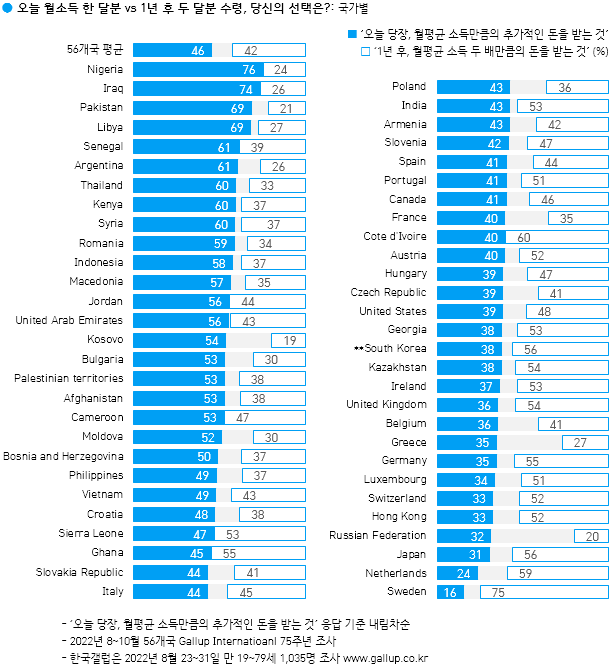
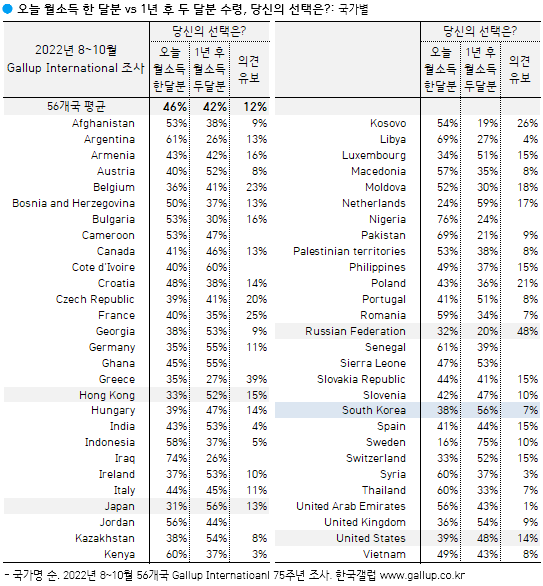
──
한국인 38% '오늘 월소득 한 달분', 56% '1년 후 두 달분 수령'
- 저소득·생활수준 낮을수록, 60·70대 현재 지향적
한국인 중에서는 38%가 '오늘 당장 월소득 한 달분 수령', 56%가 '1년 후 두 달분 수령'을 선택했고 7%는 의견을 유보했다. 재정상 현재 지향성 기준으로 보면 56개국 평균을 밑돌며, G7 또는 EU 국가에 해당하는 수준이다. 이는 지난 연말 36개국 조사에서 한국의 가계 상황 인식이 다른 나라보다 안정적이었던 것과도 맥을 같이한다(→ G20230119).
◎ '오늘 월소득 한 달분 수령' 선택을 응답자 특성별로 보면 저소득일수록(200만 원 미만 53%; 700만 원 이상 27%), 주관적 생활수준이 낮을수록(하층 59%; 상/중상 32%), 60·70대(53%; 20대 27%)에서 많은 편이다.
참고로, 2021년 12월 기준 우리나라 임금노동자의 월평균 소득은 333만 원, 중위소득은 250만 원이다(→ 통계청 일자리행정통계). 같은 해 전국 가구의 균등화 중위소득(처분가능소득 기준)은 연 3,174만 원(명목, 월 265만 원), 4인 가구 중위소득은 연 4,876만 원이다(월 406만 원, → 가계금융복지조사).
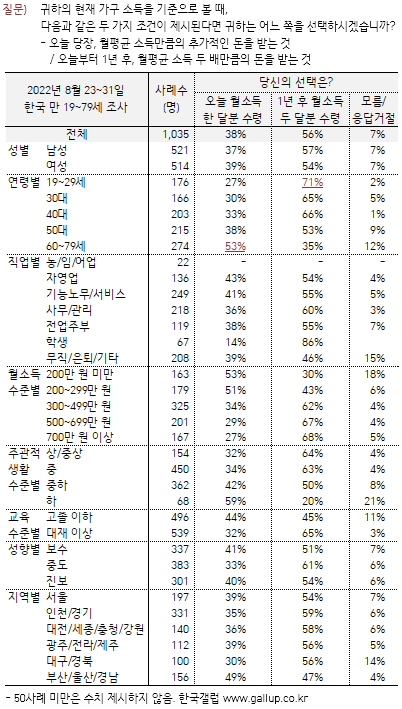
──────────────────
The World is Divided on Financial Reward
──────────────────
The world’s population is divided when it comes to their urgency for money – 46% of us would prefer gaining some amount of money now, while 42% are willing to wait 12 months to get double the amount.
Data is from a special poll conducted by Gallup International Association (GIA) in 56 countries covering over two thirds of the global population (and more than 90% of those countries which are free to conduct and publish opinion research). The poll celebrates GIA’s 75th anniversary.
The respondents were asked to think about their current household income and choose between receiving an extra payment today, equaling their normal monthly income, or receiving an extra payment, equal to twice their monthly income, but in a year. The question refers to a popular notion in psychology and behavioral economics – present bias or our tendency to prefer a smaller immediate prize over a greater prize in the future.
Results show rather divided opinions around the world – 46% show a present bias, while 42% are more prone to place their future self in greater importance.
With immediate financial struggles perhaps top of mind, people from lower income countries seem more prone to choose some reward now, despite it being smaller – 53% vs. 42%. The higher the national income, the more prone to express preferences towards a greater reward in the future – 38% vs. 48% in the wealthiest countries.
Age seems to have a rather insignificant effect on respondents’ views, although younger generations seem a bit less prone to exhibiting present bias. Personal income and education seem more defining in people’s attitudes on future wellbeing-present improving dilemma. The higher the income and education, the lower present bias orientations.
The regions of MENA and Latin America are leading the present bias ranking – with shares of over 60% confirming they would rather receive one monthly payment now. On the other end of the scale are the EU and North America – shares of around 40%.
Nigeria, Iraq and Pakistan – top the list with 76%, 74% and 69% – showing present bias. World’s richest and more developed countries show least present bias – 16% in Sweden, 24% in the Netherlands, 31% in Japan.
Of note is the case of the USA and the Russian Federation. People in Russia for instance show a rather small present bias (32%), but also the greatest share of respondents, who cannot choose an option – 48%. The remaining 20% express preferences towards a greater reward in the future. While those in the USA are also among the nations that show a lesser incline towards present bias – 39%, with 48% oriented towards the future (and 14% undecided).
Overall it seems that, together with the answers to the questions “How far is the future?” and “How much do I need the money right now?” uncertainty also defines our reward preferences.
Kancho Stoychev,
President of Gallup International Association:
“In a way this bias indicator is related much more to the assessment of the present rather than to the future. Although our minds are permanently planning “what’s next“, our lives depend on what they are now. And if we consider our “now” stable and satisfactory, we tend to postpone the “more” for the future. That is why we can call this bias indicator also a stability perception indicator, because as Nicholas Taleb once said: Stability is progress without impatience."
──
한국 응답자 특성표
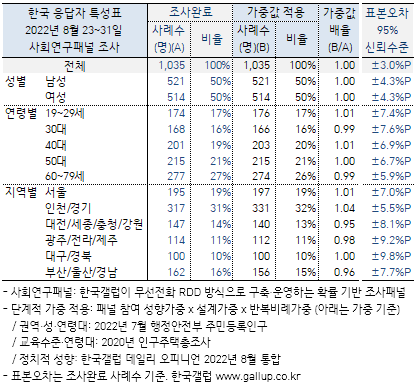
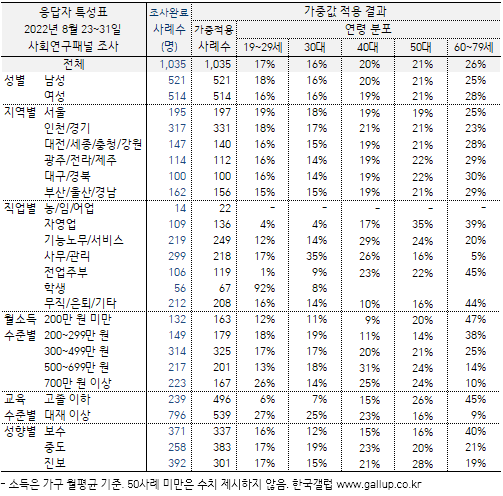
| 1947년 조지 갤럽 박사가 설립한 갤럽 인터내셔널(Gallup International Association)은 매년 전 세계 회원사 공동으로 주요 현안에 관한 여론을 조사합니다. 2022년 가을에는 설립 75주년을 기념하는 조사를 했고, 올해 상반기 몇 차례에 걸쳐 그 결과를 전하고 있습니다. 〈경제·안보 전략적 파트너〉 〈현세대 삶 평가, 다음 세대 삶 전망〉 〈국외 이주 의향〉 〈향후 25년간 전망 10가지〉 〈종교적 성향과 실재〉에 이어, 오늘은 재정상 현재 지향성에 관해 알려드립니다. → Press release for the 120th Anniversary of Dr. George Gallup |
오늘 월소득 한 달분 vs 1년 후 두 달분 수령, 당신의 선택은?
Gallup International 75주년 다국가 조사
→ 한국+세계 조사 결과 파일 다운로드(PDF)
/ 세계 조사 개요
- 2022년 8~10월 56개국 성인 총 53,321명 전화/온라인/면접조사(주제별 참여국 상이)
/ 한국 조사 개요
- 조사기간: 2022년 8월 23~31일
- 표본추출: 사회연구패널★에서 성·연령·지역별 층화 추출
(한국갤럽이 무선전화 RDD 방식으로 구축·운영하는 확률 기반 조사패널)
- 응답방식: 모바일조사(조사대상자에게 문자메시지 발송, 자기기입식 웹조사)
- 조사대상: 전국 만 19~79세 1,035명
- 표본오차: ±3.0%포인트(95% 신뢰수준)
- 문자 발송 대비 응답 완료율: 46%(총 2,263명 중 1,035명)
- 의뢰처: 한국갤럽-Gallup International 자체 조사
조사 결과
2022년 8~10월 56개국 시민의 추가 소득 수령에 관한 생각 양분:
'오늘 당장 월소득 한 달분' 46%, '1년 후 월소득 두 달분' 42%
- 저소득 국가 현재 지향성 강한 편, 재정상 절박함·미래 불확실성 연관
갤럽 인터내셔널이 2022년 8~10월 56개국 시민 53,321명에게 소득 관련 두 가지 조건-오늘 당장 월평균 소득만큼의 추가적인 돈을 받는 것과 1년 후 월평균 소득 두 배만큼의 돈을 받는 것-이 제시된다면 어느 쪽을 선택할 것인지 물었다. 이는 심리학·행동경제학에서의 '현재 편향(present bias)', 미래의 더 큰 보상보다 작지만 즉각적인 보상 선호 경향을 엿볼 수 있는 질문이다. 조사 참여자들의 생각은 양분됐다. 46%가 '오늘 당장 월소득 한 달분 수령', 42%는 '1년 후 두 달분 수령'을 선택했고 12%는 의견을 유보했다.
◎ '오늘 당장 월소득 한 달분 수령' 의향자가 많은, 즉 재정상 현재 지향성이 강한 나라는 나이지리아(76%), 이라크(74%), 파키스탄·리비아(69%), 세네갈·아르헨티나(61%), 타이·케냐·시리아(60%) 순이며, 스웨덴(16%)과 네덜란드(24%)에서는 그 비율이 30%를 넘지 않았고 일본(31%)을 비롯한 G7 국가는 모두 56개국 평균(46%)을 밑돌았다: 이탈리아 44%, 캐나다 41%, 프랑스 40%, 미국 39%, 영국 36%, 독일 35%.
◎ 재정상 현재 지향성을 권역별로 보면 중남미와 MENA(중동·북아프리카)(61%)에서 가장 두드러지고, 그 반대편에 북미(40%)와 EU(39%) 국가가 자리한다. 저소득 국가에서는 작지만 즉각적인 보상을, 고소득 국가에서는 미래의 더 큰 보상을 더 원했다. 국가뿐 아니라 개인 재정 측면에서도 저소득자의 현재 지향성이 강한 편이다. 한편, 이러한 현재 지향성은 재정상 절박함뿐 아니라 정치·사회적 불안, 국가 간 갈등·무력 분쟁 등 외부 상황과도 연관된다. 당장 돈이 필요치 않은 상황이라도, 앞날의 불확실성을 크게 느끼거나 현재의 확실한 이득을 중시하는 사람은 '1년 후 월소득 두 달분'보다 '오늘 당장 월소득 한 달분'을 선택할 가능성이 크다.


──
한국인 38% '오늘 월소득 한 달분', 56% '1년 후 두 달분 수령'
- 저소득·생활수준 낮을수록, 60·70대 현재 지향적
한국인 중에서는 38%가 '오늘 당장 월소득 한 달분 수령', 56%가 '1년 후 두 달분 수령'을 선택했고 7%는 의견을 유보했다. 재정상 현재 지향성 기준으로 보면 56개국 평균을 밑돌며, G7 또는 EU 국가에 해당하는 수준이다. 이는 지난 연말 36개국 조사에서 한국의 가계 상황 인식이 다른 나라보다 안정적이었던 것과도 맥을 같이한다(→ G20230119).
◎ '오늘 월소득 한 달분 수령' 선택을 응답자 특성별로 보면 저소득일수록(200만 원 미만 53%; 700만 원 이상 27%), 주관적 생활수준이 낮을수록(하층 59%; 상/중상 32%), 60·70대(53%; 20대 27%)에서 많은 편이다.
참고로, 2021년 12월 기준 우리나라 임금노동자의 월평균 소득은 333만 원, 중위소득은 250만 원이다(→ 통계청 일자리행정통계). 같은 해 전국 가구의 균등화 중위소득(처분가능소득 기준)은 연 3,174만 원(명목, 월 265만 원), 4인 가구 중위소득은 연 4,876만 원이다(월 406만 원, → 가계금융복지조사).

──────────────────
The World is Divided on Financial Reward
──────────────────
The world’s population is divided when it comes to their urgency for money – 46% of us would prefer gaining some amount of money now, while 42% are willing to wait 12 months to get double the amount.
Data is from a special poll conducted by Gallup International Association (GIA) in 56 countries covering over two thirds of the global population (and more than 90% of those countries which are free to conduct and publish opinion research). The poll celebrates GIA’s 75th anniversary.
The respondents were asked to think about their current household income and choose between receiving an extra payment today, equaling their normal monthly income, or receiving an extra payment, equal to twice their monthly income, but in a year. The question refers to a popular notion in psychology and behavioral economics – present bias or our tendency to prefer a smaller immediate prize over a greater prize in the future.
Results show rather divided opinions around the world – 46% show a present bias, while 42% are more prone to place their future self in greater importance.
With immediate financial struggles perhaps top of mind, people from lower income countries seem more prone to choose some reward now, despite it being smaller – 53% vs. 42%. The higher the national income, the more prone to express preferences towards a greater reward in the future – 38% vs. 48% in the wealthiest countries.
Age seems to have a rather insignificant effect on respondents’ views, although younger generations seem a bit less prone to exhibiting present bias. Personal income and education seem more defining in people’s attitudes on future wellbeing-present improving dilemma. The higher the income and education, the lower present bias orientations.
The regions of MENA and Latin America are leading the present bias ranking – with shares of over 60% confirming they would rather receive one monthly payment now. On the other end of the scale are the EU and North America – shares of around 40%.
Nigeria, Iraq and Pakistan – top the list with 76%, 74% and 69% – showing present bias. World’s richest and more developed countries show least present bias – 16% in Sweden, 24% in the Netherlands, 31% in Japan.
Of note is the case of the USA and the Russian Federation. People in Russia for instance show a rather small present bias (32%), but also the greatest share of respondents, who cannot choose an option – 48%. The remaining 20% express preferences towards a greater reward in the future. While those in the USA are also among the nations that show a lesser incline towards present bias – 39%, with 48% oriented towards the future (and 14% undecided).
Overall it seems that, together with the answers to the questions “How far is the future?” and “How much do I need the money right now?” uncertainty also defines our reward preferences.
Kancho Stoychev,
President of Gallup International Association:
“In a way this bias indicator is related much more to the assessment of the present rather than to the future. Although our minds are permanently planning “what’s next“, our lives depend on what they are now. And if we consider our “now” stable and satisfactory, we tend to postpone the “more” for the future. That is why we can call this bias indicator also a stability perception indicator, because as Nicholas Taleb once said: Stability is progress without impatience."
──
한국 응답자 특성표

